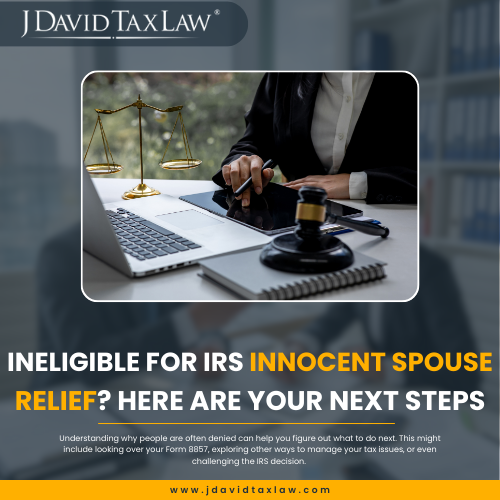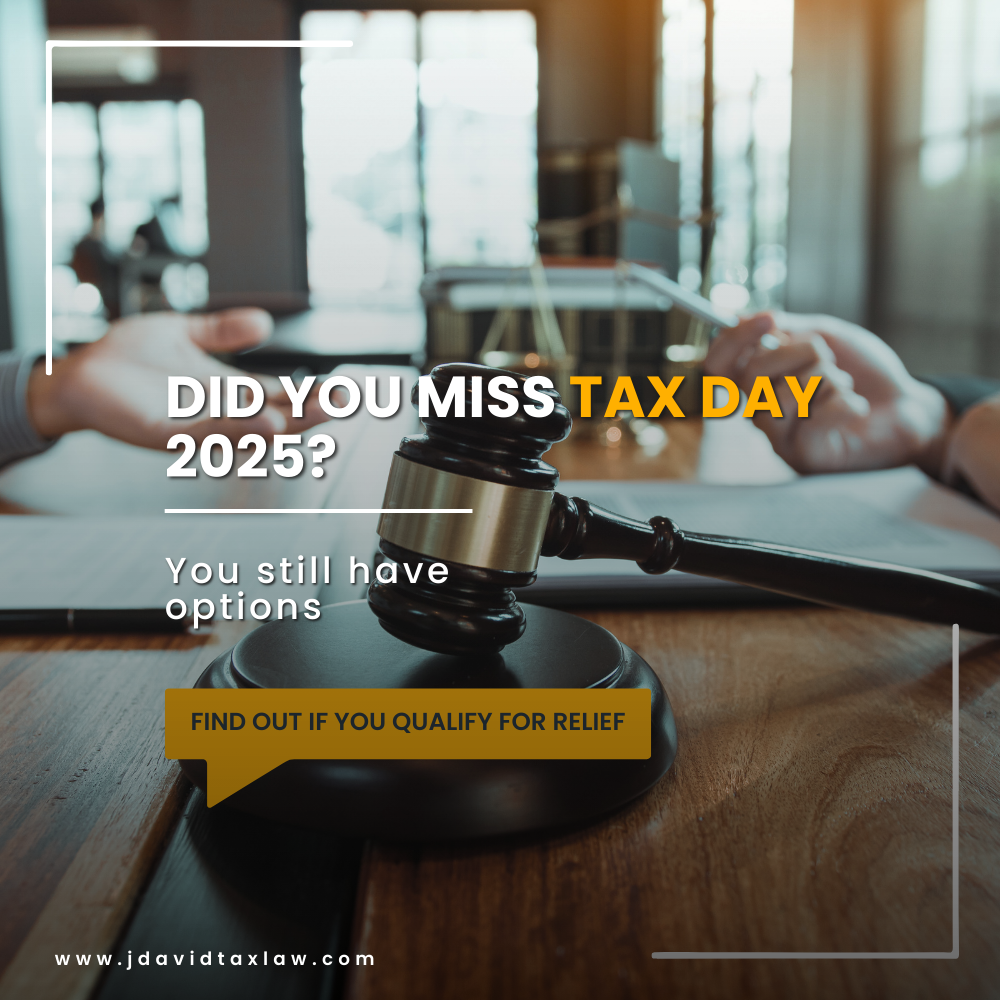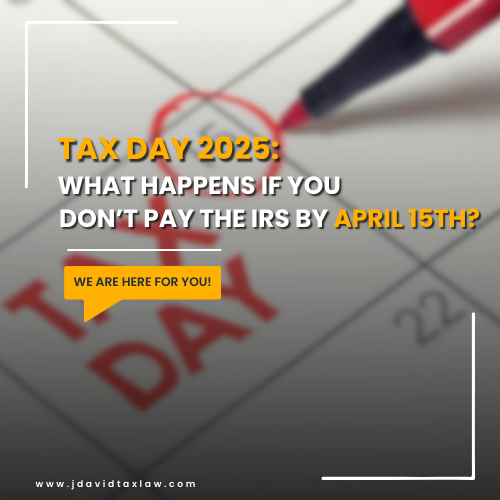Signing a joint tax return means you and your spouse share responsibility for any taxes due. But what if your spouse made mistakes or left out information on the tax return without your knowledge? The IRS offers Innocent Spouse Relief to help people who find themselves in this unfair situation. IRS Innocent Spouse Relief have four types: Innocent Spouse Relief, Separation of Liability Relief, Equitable Relief, and Relief from Liability Arising from Community Property Law.
Innocent Spouse Relief can protect you from being held liable for your spouse’s (or ex-spouse’s) tax errors. Yet, getting this relief is not straightforward. Many applications are turned down due to reasons like not meeting strict criteria, missing the submission deadlines, or failing to provide enough proof. Understanding why people are often denied can help you figure out what to do next. This might include looking over your Form 8857, exploring other ways to manage your tax issues, or even challenging the IRS decision.
Want to know the most common pitfalls that lead to the denial of Innocent Spouse Relief? Keep reading!
Key Factors Leading to Innocent Spouse Relief Denial
Don’t let the denial of your Innocent Spouse Relief application discourage you. The fact that only 4,807 out of 26,179 applicants in 2021 were accepted shows how complex this process can be. Let’s break down some of the common reasons why applications get denied and what you can do about it.
Failing to Meet IRS Criteria
The main reason applications are turned down is that they don’t meet the IRS’s strict rules. To get the Innocent spouse relief, you need to show that you didn’t know about the tax mistakes made. This can be hard to prove and usually requires a lot of detailed information like bank records or emails.
Insufficient Evidence Submitted with Form 8857
Another big reason for denial is not having enough proof. The IRS needs solid evidence that you weren’t involved in the tax error. This means having clear documents that show you were not part of the financial decisions that led to the problem.
Click here to learn about the various types of Innocent Spouse Relief and the eligibility criteria.
Understanding and Acting on Relief Denial
When the IRS denies your request for relief, it involves a combination of understanding the reasons and knowing how to respond effectively. Here are some simple tips to guide you:
Reviewing the Denial Letter
If your application is denied, the IRS will send you a denial letter (Notice of Determination) that explains why. It’s important to read this letter carefully because it tells you exactly what the IRS thought was missing or wrong with your application. Understanding these points can help you figure out what to fix if you decide to apply again or appeal the decision.
Identify Key Issues: Make note of each reason the IRS provides. These reasons often pinpoint the exact areas where your application failed to meet IRS criteria.
Documentation Gaps: Look for any mentions of insufficient documentation. Perhaps more detailed financial records or additional evidence could sway the decision.
Misunderstandings or Errors: Sometimes, denials result from misunderstandings or incorrect information. Identifying these can be crucial for an effective appeal.
Administrative Guidance
The IRS provides guidelines, like the ones in Form 8857, on how to apply for Innocent Spouse Relief. Looking over these guidelines can help you understand what information and documents you need to provide to meet the IRS’s expectations.
Checklist of Requirements: Form 8857 outlines specific requirements and documentation needed. Ensure you follow this checklist precisely to avoid missing critical pieces of information.
Examples and Scenarios: The form and guidelines often include examples that can help you understand how to present your situation clearly and effectively.
Updates and Changes: Tax laws and IRS guidelines can change. Always check that you are using the most current forms and instructions to ensure compliance with the latest rules.
Interpreting the IRS’s Explanation
The language used in IRS letters often includes complicated legal terms that can be challenging to understand. If you find yourself confused by the details in these communications, consulting with a tax expert can be incredibly helpful. An A+ rated tax professional like J. David Tax Law, with a collective experience of over 40 years, can help clarify these complex explanations and guide you on the best steps to take next.
Challenge Your Innocent Spouse Relief Denial
If your application for Innocent Spouse Relief has been denied by the IRS, it’s not the end of the road. You have the opportunity to challenge this decision (appeal the IRS decision) and potentially overturn it. This involves understanding the appeals process, preparing a strong case, and knowing your rights. Here’s how you can start the process of challenging your Innocent Spouse Relief denial to seek a fair resolution.
Understand The Appeals Process
You usually have 90 days from when you receive the Notice of Determination to file an appeal. Your appeal must be written, stating clearly that you disagree with the IRS and wish to challenge their decision in Tax Court using IRS Form 12509, Statement of Disagreement.
Prepare Your Documentation for IRS Spouse Relief
Look over the reasons why your application was denied, which are listed in your Denial Letter. Gather all relevant documents, such as financial statements, emails, or legal documents that prove you were unaware of the mistakes made on your tax returns.
Write a Clear Appeal Letter
Your appeal letter should clearly state the facts and explain why you think the decision was wrong. It’s important to mention specific tax laws or IRS rules that support your case. Keep your letter clear and to the point, and attach all supporting documents.
Follow Through
After sending your appeal, keep an eye on any replies from the IRS and respond quickly to any further information they might need. The appeal process can take a while, so patience and careful attention to detail are important.
Remember, tax laws can be complex, and having one of our tax attorneys assist you can make a significant difference—with an absolutely free initial consultation.They can ensure your appeal is well-prepared, adheres to all legal guidelines, and presents a strong argument on your behalf.
Know Your Option: Innocent Spouse VS Injured Spouse Relief
If you discover that you do not qualify for any of the four types of Innocent Spouse Relief—Innocent Spouse Relief, Separation of Liability Relief, Equitable Relief, or Relief from Liability Arising from Community Property Law—it’s important to consider if Injured Spouse Relief may be applicable to your situation. Injured Spouse Relief is specifically designed for taxpayers looking to protect their portion of a joint tax refund from being used to satisfy their spouse’s separate outstanding debts, such as federal taxes, state income taxes, child or spousal support, or other federal non-tax debts like student loans. To apply for Injured Spouse Relief, you should file Form 8379, Injured Spouse Allocation, which ensures that the tax refund is fairly divided, allowing you to receive your share unaffected by your spouse’s financial obligations.
Alternative Tax Relief Options
With our expert tax specialists on your side, your appeal is set up for success, greatly reducing the likelihood of denial. However, if it’s denied for any reason, or if you choose to explore alternatives, there are several other tax relief options available to help manage your tax liabilities effectively. Understanding these alternatives can provide you with viable pathways to resolve your tax issues in a way that fits your financial situation. Here’s a detailed look at some common tax relief strategies and how to determine the best choice for your circumstances:
Offer in Compromise (OIC)
This option allows you to settle your tax debts for less than the full amount owed, providing a significant financial relief if you meet the IRS criteria. The process involves submitting a proposal to the IRS that outlines how much you can pay. The IRS will consider your income, expenses, asset equity, and ability to pay when evaluating your proposal. An OIC is ideal for those who cannot pay their full tax liabilities without causing financial hardship. See how our tax law firm can help you Settle your IRS tax debt for less than the full amount owed through effective negotiation with an Offer in Compromise.
Installment Agreement
If you’re unable to pay your tax debt in full, you may qualify for an Installment Agreement with the IRS, which allows you to make monthly payments over time. This is one of the most commonly used tax relief options and can be arranged for a period that reflects your ability to pay. It’s suitable for individuals who can meet regular payment obligations but need an extended timeframe to clear their tax dues. Check if you’re eligible for an IRS installment agreement and Reset your financial status with the IRS through our Fresh Start Program.
Currently Not Collectible (CNC)
If paying your back taxes would prevent you from covering basic living expenses, you might qualify for Currently Not Collectible status. Under CNC, the IRS temporarily halts collection activities until your financial situation improves. This doesn’t waive the tax owed but provides relief from the pressure of immediate payments. See how our tax debt attorneys can delay IRS collection actions due to financial hardship with Currently Not Collectible status
Penalty Abatement
If you have a reasonable cause for not meeting tax obligations, such as illness or natural disaster, you might qualify for penalty abatement. This relief option can reduce or remove penalties associated with failing to file or pay taxes on time, helping to lower your overall tax debt.
Did you know J David Tax Law helped secure a full waiver of $150,888 in penalties and interest for one of its clients,Ryan, through this penalty abatement program?
To decide which tax relief strategy is best for your situation, consider your current financial status, the total amount of tax debt, and your future income potential. It’s also wise to consult with a tax professional who can offer personalized advice based on a detailed assessment of your circumstances.
Preventive Measures for the Future
Dealing with tax issues can be stressful and time-consuming. To help prevent similar challenges in the future, it’s important to adopt proactive strategies when filing taxes and managing finances. Here are some effective tips and resources to help you stay on top of your tax responsibilities and avoid potential problems:
If your Innocent Spouse Relief application has been denied, don’t worry—we’re here to help. Call us at (888) 342-9436 for a free consultation, and we’ll explore every possible option to address your situation.
Your Tax Relief Questions, Answered















